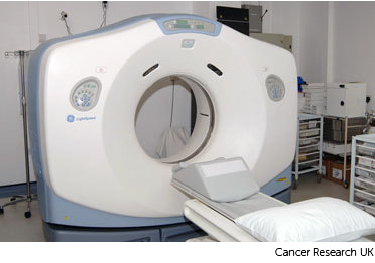Planning external radiotherapy for vaginal cancer
The radiotherapy team plans your external beam radiotherapy before you start treatment. This means working out the dose of radiotherapy you need and exactly where you need it.
Your planning appointment takes from 15 minutes to 2 hours.
The planning CT scan
You usually have a planning CT scan in the radiotherapy department.
The scan shows the cancer and the area around it. You might have other types of scans or x-rays to help your treatment team plan your radiotherapy. The plan they create is just for you.

Your radiographers tell you what will happen during the planning CT scan.
Before the scan
Before the scan you might need to empty your bowels and bladder. Your radiographer might give you an  to help you empty your bowels. You may also need to drink a certain amount of water before you have the scan. They will tell you how much.
to help you empty your bowels. You may also need to drink a certain amount of water before you have the scan. They will tell you how much.
If your bladder is not full enough, or your bowels aren’t empty enough, they may need to repeat the scan. You may need to prepare your bowels and bladder in the same way before each treatment. This helps to reduce side effects to your bladder and bowels.
Your radiographer will ask you to put on a hospital gown. When you’re ready, the radiographers help you to position yourself on the scanning couch. This is the same type of bed that you lie on for your treatment sessions.
You need to lie very still. You might have a type of firm cushion called a vacbag to help as you may be in this position for a little while. Let the radiographers know if you are uncomfortable.
Having the scan
Once you're in a comfortable position the radiographers move the couch up and through the scanner. They then leave the room and the scan starts.
The scan takes about 5 minutes. You won't feel anything. The radiographers can see you from the CT control area where they operate the scanner.
Injection of dye
You might need an injection of  through a small thin tube (cannula) in your arm.
through a small thin tube (cannula) in your arm.
Before you have the contrast medium, the radiographer asks you about any medical conditions or allergies. Some people are allergic to the dye.
For some people the dye might:
• make you feel hot and flushed for a minute or two
• give you a metallic taste in your mouth, but this will not last long
• make you feel like you’re passing urine but you aren’t. This feeling usually passes quickly
Ink and tattoo marks
The radiographers make pin point sized tattoo marks on your skin. They use these marks to line you up into the same position every day. The tattoos make sure they treat exactly the same area for all of your treatments. They may also draw marks around the tattoos with a permanent ink pen, so that they are clear to see when the lights are low.

The radiotherapy staff tell you how to look after the markings. The pen marks might start to rub off in time, but the tattoos won’t. Tell your radiographer if that happens. Don't try to redraw them yourself.
After the scan
The radiographers will then help you off the CT scanner couch and you can get changed back into your clothes. You stay in the department for about 15 to 30 minutes if you had an injection of the dye. This is in case it makes you feel unwell, which is rare.
The radiographer removes the tube from the vein in your arm before you go home.
You should be able to go home or back to work. You can eat and drink normally.
Possible risks
A CT scan is safe for most people but there are some possible risks. Your doctor and radiographer make sure the benefits of having the scan outweigh these risks.
Allergic reaction
Rarely, people have an allergic reaction to the contrast medium. This most often starts with weakness, sweating and difficulty breathing. Tell your radiographer immediately if you feel unwell so they can give you medicine to treat the reaction.
Contrast medium
There is a risk that the contrast medium will leak outside the vein. This can cause swelling and pain in your arm but it’s rare.
Radiation
Exposure to radiation during a CT scan can slightly increase your risk of developing cancer in the future. Talk to your doctor if this worries you.
Pregnancy
Pregnant women should only have CT scans in emergencies. Contact the department as soon as you can before the scan if you are pregnant or think that you might be.
After your planning session
You might have to wait a few days or up to 3 weeks before you start treatment.
During this time the physicists and your radiotherapy doctor (clinical oncologist) decide the final details of your radiotherapy plan. They make sure that the area of the cancer will receive a high dose and nearby areas receive a low dose. This reduces the side effects you might get during and after treatment.



